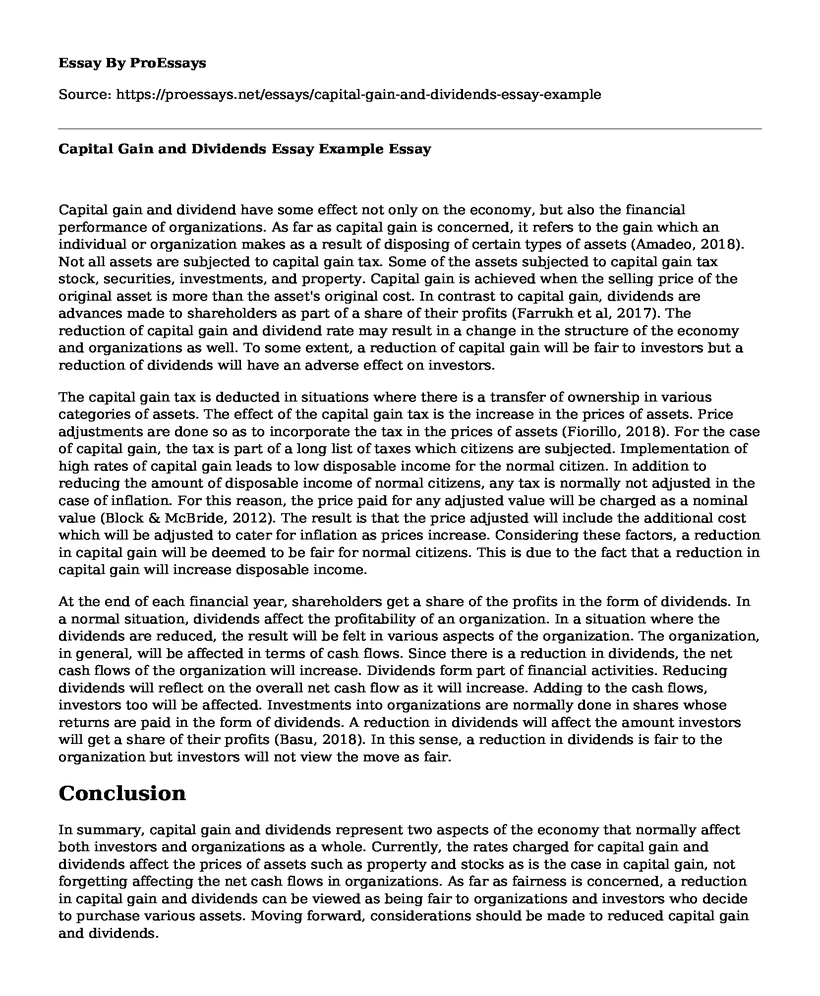Capital gain and dividend have some effect not only on the economy, but also the financial performance of organizations. As far as capital gain is concerned, it refers to the gain which an individual or organization makes as a result of disposing of certain types of assets (Amadeo, 2018). Not all assets are subjected to capital gain tax. Some of the assets subjected to capital gain tax stock, securities, investments, and property. Capital gain is achieved when the selling price of the original asset is more than the asset's original cost. In contrast to capital gain, dividends are advances made to shareholders as part of a share of their profits (Farrukh et al, 2017). The reduction of capital gain and dividend rate may result in a change in the structure of the economy and organizations as well. To some extent, a reduction of capital gain will be fair to investors but a reduction of dividends will have an adverse effect on investors.
The capital gain tax is deducted in situations where there is a transfer of ownership in various categories of assets. The effect of the capital gain tax is the increase in the prices of assets. Price adjustments are done so as to incorporate the tax in the prices of assets (Fiorillo, 2018). For the case of capital gain, the tax is part of a long list of taxes which citizens are subjected. Implementation of high rates of capital gain leads to low disposable income for the normal citizen. In addition to reducing the amount of disposable income of normal citizens, any tax is normally not adjusted in the case of inflation. For this reason, the price paid for any adjusted value will be charged as a nominal value (Block & McBride, 2012). The result is that the price adjusted will include the additional cost which will be adjusted to cater for inflation as prices increase. Considering these factors, a reduction in capital gain will be deemed to be fair for normal citizens. This is due to the fact that a reduction in capital gain will increase disposable income.
At the end of each financial year, shareholders get a share of the profits in the form of dividends. In a normal situation, dividends affect the profitability of an organization. In a situation where the dividends are reduced, the result will be felt in various aspects of the organization. The organization, in general, will be affected in terms of cash flows. Since there is a reduction in dividends, the net cash flows of the organization will increase. Dividends form part of financial activities. Reducing dividends will reflect on the overall net cash flow as it will increase. Adding to the cash flows, investors too will be affected. Investments into organizations are normally done in shares whose returns are paid in the form of dividends. A reduction in dividends will affect the amount investors will get a share of their profits (Basu, 2018). In this sense, a reduction in dividends is fair to the organization but investors will not view the move as fair.
Conclusion
In summary, capital gain and dividends represent two aspects of the economy that normally affect both investors and organizations as a whole. Currently, the rates charged for capital gain and dividends affect the prices of assets such as property and stocks as is the case in capital gain, not forgetting affecting the net cash flows in organizations. As far as fairness is concerned, a reduction in capital gain and dividends can be viewed as being fair to organizations and investors who decide to purchase various assets. Moving forward, considerations should be made to reduced capital gain and dividends.
References
Amadeo, K. (2018). Capital gains tax, rates, and impact. The Balance. Retrieved from https://www.thebalance.com/what-is-the-capital-gains-tax-3305824
Basu, C. (2018). What happens when a company cuts its dividends? Chron. Retrieved from https://smallbusiness.chron.com/happens-company-cuts-its-dividends-22915.html
Block, D. & McBride, W. (2012). Why capital gains are taxed at a lower rate. Tax Foundation. Retrieved from https://taxfoundation.org/why-capital-gains-are-taxed-lower-rate/
Farrukh, K. et al. (2017). Impact of dividend policy on shareholders wealth and firm performance in Pakistan. Cogent Business & Management, 4(1), 1408208.
Fiorillo, S. (2018). What is capital gains tax and when are you exempt? The Street. Retrieved from https://www.thestreet.com/personal-finance/taxes/capital-gains-tax-14717438
Cite this page
Capital Gain and Dividends Essay Example. (2022, Oct 05). Retrieved from https://proessays.net/essays/capital-gain-and-dividends-essay-example
If you are the original author of this essay and no longer wish to have it published on the ProEssays website, please click below to request its removal:







